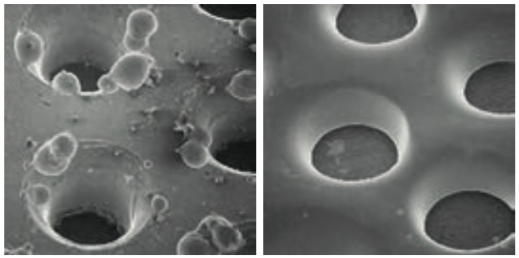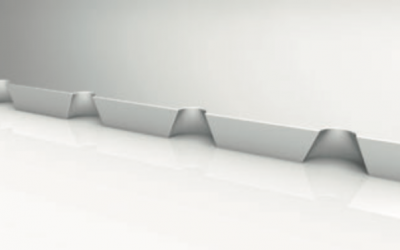What distinguishes an IMS precision sieve from the standard?
The big difference to standard sieves is the high level of manufacturing. Since we are dealing with espresso in the µ-meter range and the grain size of the ground coffee is around 200 to 300 µm, the perforation of the sieves should be examined with this level of precision. Barely visible to the naked eye, a big difference can be seen under the microscope.

As can be clearly seen in Figure 1, the holes are free of production residues. Production residues can cause the holes to become clogged with ground coffee. With IMS, the surface is smoothly polished and the holes are more precisely formed, which ensures a more even extraction and a noticeably better result in the cup, which can also be confirmed by measuring with a refractometer. Another advantage of the smoothly polished surface of the IMS sieve is that less coffee residue is left in the sieve when the coffee grounds are knocked off. In addition, fewer coffee fines come through the sieve, which tend to collect at the bottom of the cup and remain unpleasantly on the tongue after the last sip.
IMS - Development of precision sieves
IMS-Filtri has perfected the shape of the holes through constant improvement and in collaboration with well-known companies for barista championships. With a conical, tapered hole, which is only available on IMS sieves, the aromas in the espresso are even more pronounced (Figure 2). Even the crema has a finer texture, which is considered to be more pleasant in the mouth. Comparable to fine-pored milk foam in a cappuccino.

Since the sieve specialists, such as IMS, do not just commit to one size, they are available in almost all sensible sizes and grammages. For different types of coffee, significantly better results can be achieved with the ideal grammage. The rule of thumb of 7 grams in 25 seconds, from the Italian textbook, works well. However, a significantly better result can be achieved with a variation of this. This is something the world's top baristas prove every day. For example, if a fine Arabica is brewed, the grammage can taste much better with as much as 11 grams.
The mistake that is often made is that the sieves are either overfilled or not enough ground coffee is put in. If the sieve is underfilled, the coffee grounds are washed out and the machine cannot build up a reasonable amount of pressure. This means that the coffee is very poorly extracted and a lot of water always collects on the coffee puck or becomes very mushy. If the sieve is overfilled, the portafilter hardly fits into the brewing group and the ground coffee is pressed into the brewing shower, which can result in an espresso that tastes "burnt". And the shower is more quickly contaminated by coffee residue, which then has a negative effect on the next extraction.
